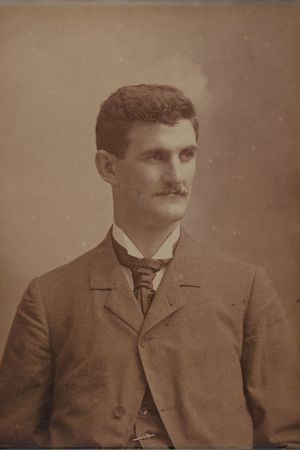Can you imagine walking six miles to attend Hamilton College in the l890 period? Clarence William Mason did it and graduated with the class of l892.
Mason was born on a Vernon Center farm on March 11, 1868, but his life took him far away from that rural community of Oneida County.
 After early study in a one-room school, he took his secondary school training at Bestīs Boys School in Clinton, where he excelled as a student.
Bestīs Boys was a merger of the Clinton Grammar School and Dwightīs Rural High School and was located at 86-88 College Street in the twilight of private schools in Clinton. Called Bestīs from l875- 91, it closed in 1891 as the Clinton Union School and Academy on Marvin Street was under construction. When the Union School opened in September 1893, it effectively ended the era of private secondary schools here.
After early study in a one-room school, he took his secondary school training at Bestīs Boys School in Clinton, where he excelled as a student.
Bestīs Boys was a merger of the Clinton Grammar School and Dwightīs Rural High School and was located at 86-88 College Street in the twilight of private schools in Clinton. Called Bestīs from l875- 91, it closed in 1891 as the Clinton Union School and Academy on Marvin Street was under construction. When the Union School opened in September 1893, it effectively ended the era of private secondary schools here.
Bestīs/Clinton Grammar School/whatever it was named, basically was a prep school for Hamilton College. Several Hamilton professors served as trustees through the years.
On his family farm Mason had many duties such as plowing and planting, cultivating crops, haying, and harvesting. Oxen provided much power for farms then and Mason became good at breaking and driving oxen for daily life.
While a student at Hamilton, Mason continued to live at home and walked back and forth each day. He played football on Hamiltonīs first team and was a member of Emerson Literary Society, a fraternity.
After Hamilton, he decided to become a minister and attended Union Theological Seminary, a fraternity in New York City. He transferred to the McCormick Theological Seminary in Chicago for his last year.
Mason was called to the Congregational Church in Deansboro in l895 because his Christian sincerity and college achievements were well known there.
In l899 he married Gertrude Nanktelow of Westmoreland and brought her back to the manse in Deansboro
In 1904, after Deansboro, Mason went to the Congregational Church in Port Leyden, just north of Boonville, where he remained for five years. His next pulpit was at the Presbyterian Church in Jamesville until 1914.
After Jamesville, Masonīs life and ministry underwent a major change. He was sent into lumber camps in the Adirondacks by the Presbyterian Synod of New York and remained in that ministry until he retired in l938.
In the lumber camps Mason became acquainted with another minister, the Rev. Frank A. Reed, a pilot, and flew into lumber camps to preach the gospel to the lumberjacks. Mason also got his pilotīs license 20 years before Reed, who worked into the l950īs. Reed authored "Lumberjack Sky Pilot" and devoted one chapter to Mason.
A scan of the 1907 New Century Atlas for Oneida County shows a "CJMason" residence on the road from Vernon Center to College Hill, although it is uncertain if this was Masonīs home farm.
Masonīs walking didnīt seem to slow him up at all. He had four children: Margaret, Elinor, Isabel & Mary. He served three churches and took the Bible and Christianity to lumber camps in the mountains where he flew to spread the Gospel.
Contrast Masonīs odyssey and quest for learning, which required a six mile round-trip daily, with most college students today in any college in the country.
An active Hamilton alum, Mason attended his 45th and 50th class reunions and donated to the alumni fund. He spoke at a South Central New York alumni dinner in l947. In 1951, at the age of 83, he went to a Hamilton vs. Union football game.
Mason died at the age of 89 on October 12,1957 at the Tompkins County Memorial Hospital in Ithaca.